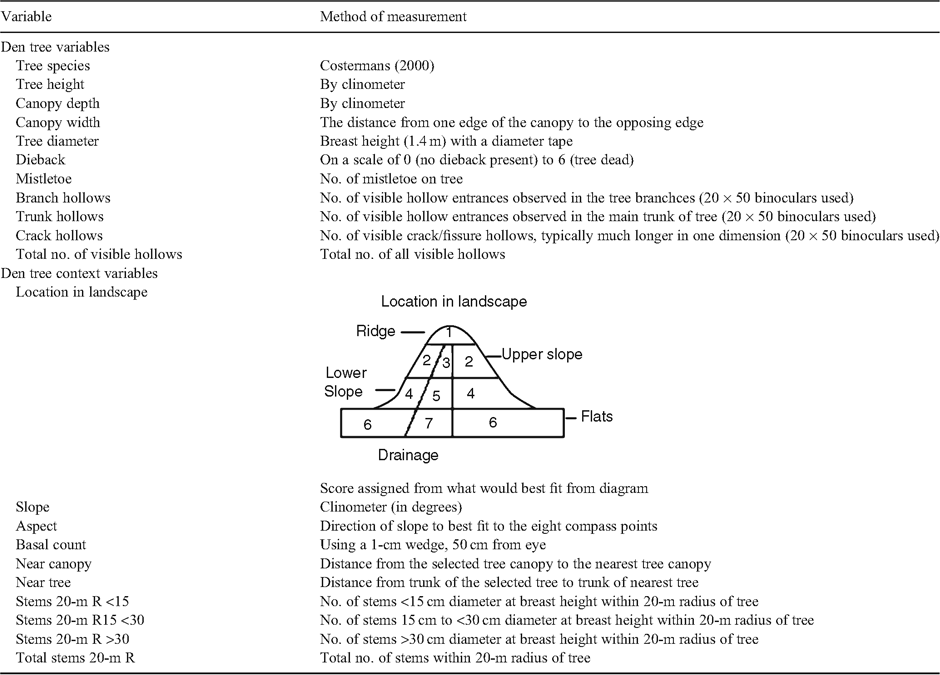The use of den trees by the squirrel glider (Petaurus norfolcensis) in temperate Australian woodlands
Mason J. Crane A B C , David B. Lindenmayer A and Ross B. Cunningham AA Fenner School of Environment and Society, The Australian National University, Canberra, ACT 0200, Australia.
B C/- 117 Sheridan St, Gundagai, NSW 2722, Australia.
C Corresponding author. Email: masoncrane@yahoo.com
Australian Journal of Zoology 58(1) 39-49 https://doi.org/10.1071/ZO09070
Submitted: 17 June 2009 Accepted: 3 February 2010 Published: 7 April 2010
Abstract
Effective conservation relies on understanding the biology of particular species and how they use key resources. For many arboreal mammals, tree hollows are a key den site. We examined the use of tree hollows by the squirrel glider (Petaurus norfolcensis) in south-eastern Australia. Over a five-month study, individual squirrel gliders used multiple hollow trees (average = 7) as den sites. Den sites were often adjacent to areas where nocturnal activities took place. The average distance between den sites used by individual gliders on successive days was 218 m. Dens were often shared by an adult pair and a juvenile. Den trees were disproportionably used, with gliders showing preference for 1–2 primary den trees often located on steep slopes. Our findings have implications for the number and spatial arrangement of den trees needed to promote the conservation of populations of the squirrel glider, particularly where land is used for agriculture and livestock grazing.
Acknowledgements
We thank the Hume and Wagga Wagga Rural Lands Protection Boards, Wagga Wagga City and Greater Hume Shire (formerly Culcairn Shire Council) Councils, and private landholders for allowing us access to their properties, Cody Keys for assistance with trapping and radio-tracking, and Damian Michael, Chris MacGregor, Ben MacDonald, Nicki Munro, and Jake Gillen. We thank our two wildlife veterinarians Karen Viggers and Arianne Lowe. We conducted trapping and radio-tracking under an Australian National University Animal Experimentation Ethics Committee permit (AEC number C.RE.39).
Bennett, A. F. , Lumsden, L. F. , and Nicholls, A. O. (1994). Tree hollows as a resource for wildlife in remnant woodlands: spatial and temporal patterns across the Northern Plains of Victoria, Australia. Pacific Conservation Biology 1, 222–235.
Cockburn, A. , and Lazenby-Cohen, K. A. (1992). The use of nest trees by Antechinus stuartii, a semelparous lekking marsupial. Journal of Zoology 226, 657–680.
| Crossref | GoogleScholarGoogle Scholar |
Cowan, P. E. (1989). Denning habitats of the common brushtail possums, Trichosurus vulpecula, in New Zealand lowland forest. Australian Wildlife Research 16, 63–78.
| Crossref | GoogleScholarGoogle Scholar |
Fischer, J. , and Lindenmayer, D. B. (2002). Small patches can be valuable for biodiversity conservation: two case studies on birds in southeastern Australia. Biological Conservation 106, 129–136.
| Crossref | GoogleScholarGoogle Scholar |
Gibbons, P. , Lindenmayer, D. B. , Fischer, J. , Manning, A. D. , Weinberg, A. , Seddon, J. , Ryan, P. , and Barrett, G. (2008). The future of scattered trees in agricultural landscapes. Conservation Biology 22, 1309–1319.
| Crossref | GoogleScholarGoogle Scholar | CAS | PubMed |
Hanski, I. K. , Stevens, P. C. , Ihalmpia, P. , and Selonen, V. (2000). Home-range size, movements, and nest-site use in the Siberian flying squirrel, Pteromys volans. Journal of Mammalogy 81, 798–809.
| Crossref | GoogleScholarGoogle Scholar |
Lapenta, M. J. , Procópio de Oliveira, P. , and Nogueira-Neto, P. (2007). Daily activity period, home range and sleeping sites of golden lion tamarin (Leontopithecus rosalia) translocated to the União Biological Reserve, RJ-Brazil. Mammalia 71, 131–137.
| Crossref | GoogleScholarGoogle Scholar |
Lindenmayer, D. B. , and Meggs, R. A. (1996). Use of den trees by Leadbeater’s possum (Gymnobelideus leadbeateri). Australian Journal of Zoology 44, 625–638.
| Crossref | GoogleScholarGoogle Scholar |
Quin, D. G. (1995). Population ecology of the squirrel glider (Petaurus norfolcensis) and the sugar glider (P. breviceps) (Marsupialia: Petauridae) at Limeburners Creek, on the central north coast of New South Wales. Wildlife Research 22, 471–505.
| Crossref | GoogleScholarGoogle Scholar |
Rowston, C. (1998). Nest- and refuge-tree usage by squirrel gliders, Petaurus norfolcensis, in south-east Queensland. Wildlife Research 25, 157–164.
| Crossref | GoogleScholarGoogle Scholar |
Soderquist, T. R. (1993). Maternal strategies of Phascogale tapoatafa (Marsupialia: Dasyuridae). I. Breeding seasonality and maternal investment. Australian Journal of Zoology 41, 549–566.
| Crossref | GoogleScholarGoogle Scholar |
van der Ree, R. (2002). The population ecology of the squirrel glider (Petaurus norfolcensis) within a network of remnant linear habitats. Wildlife Research 29, 329–340.
| Crossref | GoogleScholarGoogle Scholar |
van der Ree, R. , Bennett, A. F. , and Soderquist, T. R. (2006). Nest-tree selection by the threatened brush-tailed phascogale (Phascogale tapoatafa) (Masupialia: Dasyuridae) in a highly fragmented agricultural landscape. Wildlife Research 33, 113–119.
| Crossref | GoogleScholarGoogle Scholar |

|


